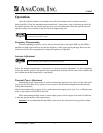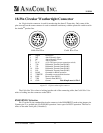
3133501
Operation
After the AnaSat
®
hardware is mounted and verified, the antenna must be aimed toward the
desired satellite. Follow the antenna/mount manufacturer’s instructions, using coordinates provided by
the satellite operator. Do not transmit until you have received authorization from the satellite network
operation center, and a transmit power level from its engineering staff.
!
A
naSat SSPA will produce RF output power the moment a modulator/driver is
connected and provides input.
Frequency Programming
Transmit operating frequency is set by the up-converter that is driving the SSPA as the SSPA is
amplifies an input signal and does not alter the frequency of the signal passing through. Please see the
instructions for the driver equipment for setting the frequency of operation.
Antenna Adjustment
!
D
o not transmit while adjusting the antenna position.
Follow the antenna manufacturer’s instructions for antenna position adjustment. For final alignment,
contact the satellite operator and get the correct polarization, azimuth, and elevation of the satellite and
also confirm the desired transponder is operational.
Transmit Power Adjustment
Maintaining proper output power is vital for maximizing signal-to-noise ratios over the radio path.
Low power levels produce noisy signals; excessive power robs downlink strength from other stations
sharing the transponder.
Adjust the modulator/driver output level to attain the desired output power level. Use a calibrated watt
meter on the output of the SSPA for this task.
When transmitting multiple carriers, run the output power with an output level back-off sufficient
to meet the spectral density mask requirements.
Caution: It is recommended that the SSPA not be driven into saturation for long periods of time.
ANACOM AnaSat
®
SSPA 17


















